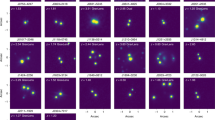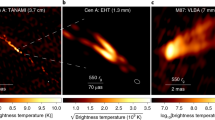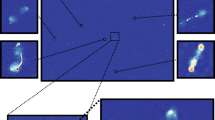Abstract
VLBI and aperture-synthesis techniques have produced better understanding of the structural details of extragalactic radio sources of both compact (<1 arc s) and extended (>10 arc s) types. Much less is known about the radio morphologies of sources with an overall size of just a few arc seconds, though such information is essential for understanding the evolutionary link between compact and extended sources. It has been predicted that the radio nucleus of a double source should appear Doppler brightened due to relativistic beaming, if the source axis is oriented close to the line of sight1–3. To investigate this, we examined two samples of double radio sources whose axes are expected to be inclined respectively at large and small angles from the line of sight. The statistics of the ‘core fraction’— fraction of the total flux of the source which is contributed by its nuclear core at some reasonably high frequency, say 5 GHz, can then be obtained. Sources with large inclination angles would probably dominate the samples of extended, well-resolved double sources and hence their core-fraction can be readily estimated from published aperture synthesis surveys. Double sources oriented close to the line of sight are expected to be more common in samples containing only those sources whose angular sizes are a couple of times smaller than the median size for that flux density range. A large, unbiased sample of this type can be constructed using the nine Ooty lunar occultation lists (see ref. 4). We have selected all sources lying north of declination −25° for which a flux density ⩾1 Jy and an overall size between 1 and 4 arc s have been estimated at 327 MHz in the occultation observations. These 30 ‘few-arc second’ sources are expected5 to be distant objects (z > 0.3) and hence intrinsically powerful radio emitters radiating >1033 erg s−1 Hz−1 at 327MHz (H0 = 50Km s−1 Mpc−1, q0 = 0.5). Sources of such high radio power have a classical double morphology6 and there exists evidence for double structure in 8 of these 30 few-arc second sources. We report here a search for compact cores among these sources by VLBI at 5 GHz using the large antennas at Effelsberg and Westerbork which provide a minimum fringe spacing of 0.045 arc s at this frequency. Radio cores were found to be much more prominent in this representative sample of 30 few arc-second sources, as compared with the cores found typically in extended double sources.
This is a preview of subscription content, access via your institution
Access options
Subscribe to this journal
Receive 51 print issues and online access
$199.00 per year
only $3.90 per issue
Buy this article
- Purchase on Springer Link
- Instant access to full article PDF
Prices may be subject to local taxes which are calculated during checkout
Similar content being viewed by others
References
Blandford, R. D., McKee, C. F. & Rees, M. J. Nature 267, 211–216 (1977).
Blandford, R. D. & Königl, A. Astrophys. J. 232, 34–48 (1979).
Scheuer, P. A. G. & Readhead, A. C. S. Nature 277, 182–185 (1979).
Joshi, M. N. & Singal, A. K. Mem. astr. Soc. India 1, 49–72 (1980).
Swarup, G. & Subrahmanya, C. R. IAU Symp. No. 74, 125–132 (1977).
Fanaroff, B. L. & Riley, J. M. Mon. Not. R. astr. Soc. 167, 31–35 (1974).
Swarup, G. Mon. Not. R. astr. Soc. 172, 501–512 (1975).
Kapahi, V. K. Mon. Not. R. astr. Soc. 172, 513–533 (1975).
Swarup, G. et al. Nature phys. Sci. 230, 185–188 (1971).
Baars, J. W. M., Genzel, R., Pauliny-Toth, I. I. K. & Witzel, A. Astr. Astrophys. 61, 99–106 (1977).
Moran, J. M. in Methods of Experimental Physics (Part C) (Academic, London, 1976).
Broderick, J. J. & Condon, J. J. Astrophys. J. 202, 596–602 (1975).
Bentley, M., Haves, P., Spencer, R. E. & Stannard, D. Mon. Not. R. astr. Soc. 173, 93–97P (1975).
Jenkins, C. J., Pooley, G. G. & Riley, J. M. Mem. R. astr. Soc. 84, 61–99 (1977).
Kapahi, V. K., Joshi, M. N. & Gopal-Krishna Astrophys. Lett. 11, 155–158 (1972).
Kus, A. J., Wilkinson, P. N. & Booth, R. S. Mon. Not. R. astr. Soc. (in the press).
Kapahi, V. K. & Schilizzi, R. T. Astr. Astrophys. Suppl. 38, 11–13 (1979).
Bolton, J. G. IAU Symp. No. 74, 85–97 (1977).
Grueff, G. & Vigotti, M. Astr. Astrophys. Suppl. 20, 57–82 (1975).
Laing, R. A., Longair, M. S., Riley, J. M., Kibblewhite, E. J. & Gunn, J. E. Mon. Not. R. astr. Soc. 183, 547–548 (1978).
Wills, B. J. Astr. J. 81, 1031–1052 (1976).
Bridle, A. H. & Fomalont, E. B. Astr. J. 83, 704–724 (1978).
Longair, M. S. & Riley, J. M. Mon. Not. R. astr. Soc. 188, 625–635 (1979).
Gopal-Krishna Astr. Astrophys. 86, L1–L2 (1980).
Miley, G. K. & Hartsuijker, A. P. Astr. Astrophys. Suppl. 34, 129–163 (1978).
Potash, R. I. & Wardle, J. F. C. Astr. J. 84, 707–717 (1979).
Venkatakrishna, K. L. & Swarup, G. Mem. astr. Soc. India 1, 25–47 (1979).
Miley, G. K. A. Rev. Astr. Astrophys. (in the press).
Strittmatter, P. A., Hill, P., Pauliny-Toth, I. I. K., Steppe, H. & Witzel, A. Astr. Astrophys. 88, L12–L15 (1980).
Gavazzi, G. & Perola, G. C. Astr. Astrophys. 66, 407–416 (1978).
Author information
Authors and Affiliations
Rights and permissions
About this article
Cite this article
Gopal-Krishna, Preuss, E. & Schilizzi, R. Prominent VLBI cores in powerful radio sources with arc second structure. Nature 288, 344–347 (1980). https://doi.org/10.1038/288344a0
Received:
Accepted:
Issue Date:
DOI: https://doi.org/10.1038/288344a0
This article is cited by
-
Extended radio structure of BL Lac type objects
Nature (1982)
-
Relativistic beaming in the central components of double radio quasars
Journal of Astrophysics and Astronomy (1982)
-
Superluminal quasar 3C179 with double radio lobes
Nature (1981)
Comments
By submitting a comment you agree to abide by our Terms and Community Guidelines. If you find something abusive or that does not comply with our terms or guidelines please flag it as inappropriate.



